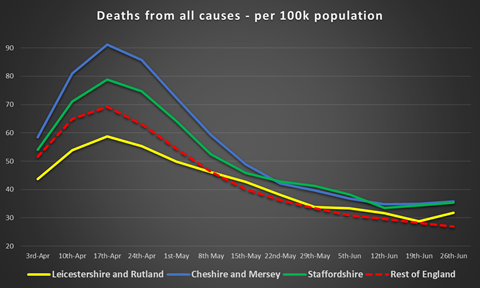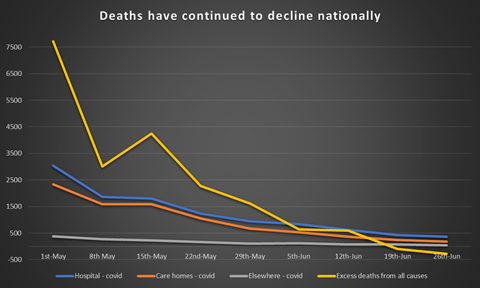- Mortality creeps back up in several systems, amid broader decline in deaths
- Two neighbouring areas have seen deaths from all causes rise for two consecutive weeks
- Sharpest rise in mortality seen in Leicestershire
Mortality rates have crept back up in some health and care systems, amid an overall decline in deaths across England.
Two neighbouring systems — Cheshire and Merseyside and Staffordshire — saw their rolling average number of deaths from all causes rise for two consecutive weeks to 26 June, following sustained falls in mortality since the peak of the coronavirus pandemic, according to analysis of Office for National Statistics data.
Cheshire and Merseyside reported reductions in deaths labelled as covid for the same period, suggesting there have been more deaths from other causes or where covid was present but not recognised on the death certificate. Staffordshire had a reduction in covid deaths in the latest week only.
Nine other systems saw an increase in their rolling average mortality rate in the most recent week, with Leciestershire seeing the biggest increase. The city of Leciester has been subject to further lockdown measures after rising covid infections rates were discovered. However, the data suggests there was no substantial increase in covid-labelled deaths in Leicestershire in this period.

Chart shows the rolling average of the mortality rate in the previous fortnight. Source: ONS - weekly data on death occurances
HSJ’s analysis used the latest weekly data from the Office for National Statistics, using the dates on which the deaths occurred. The datapoints for each week give the rolling average of deaths within the previous fortnight.
The increases in Cheshire and Mersyside were driven largely by St Helens, Liverpool and Knowsley, with Stoke-on-Trent the main driver in Staffordshire. The single district with the largest increase in the most recent weekly data was Bradford, which had 19 more deaths than the previous week.
All the council areas mentioned were approached for comment.
Data on death registrations — which can fluctuate due to local efficiency or the timings of public holidays — suggested there were around 60 “excess” deaths in Cheshire and Merseyside over the two week period (which the ONS defines as deaths above the five year average for the same period). Staffordshire had no excess deaths on this measure.
HSJ has previously highlighted the high infection and death rates in the North West and West Midlands during the first wave of coronavirus, with experts pointing to age-profiles, deprivation levels, and care home populations among the likely factors.
Meanwhile, excess deaths and those from covid-19 have continued to decline nationally.

Source: ONS - weekly data on death registrations



























No comments yet